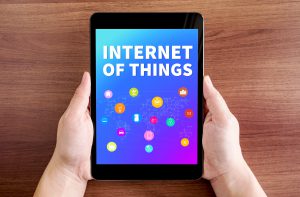Technology + Things = Services & Data

We are living in a world where refrigerators can send texts about being out of milk, printers can automatically place an order for ink over Wi-Fi when levels are low, and our steps are tracked from our watches. Driverless cars are on the horizon and houses are becoming “smart” as the Internet of Things (IoT) permeates our daily lives more and more – and we are embracing these advances.
The Internet of Things is not simply the confluence of devices and the internet, its importance lies in the services being provided to consumers. For businesses, the data that is being produced will become integral as more and more actionable data is collected and analyzed.
“I think we’re about to see a boom in mobile marketing,” shared Nick Chasse, Synergent’s Vice President for Business Development. “The tools and the technology are available. By leveraging an effective data mining strategy, credit unions have the ability to push meaningful offers to members through their mobile devices. While it’s good to be reactive, mobile marketing is a great way to proactively push offers to members for services they really need, based on an analysis of core data.”
IoT: The Game Changer
Credit Union Times recently stated that “Microsoft has called the IoT a game changer, and experts have visualized IoT devices reshaping how people live, shop and bank by transforming big data into actionable information, providing efficiency gains and powering retail activities.” They also cited that accessing small bits of information is becoming expected and, in the future, while members may not want to budget from their refrigerator door screen, they may wish to check balances and pay bills from it.
Being Part of it All
But aren’t credit unions part of the IoT already? Why is this relevant to me? Looking forward, the market value for the IoT is projected to top $3 trillion in 2025! Quietly and quickly, the IoT has become part of the credit union industry in small ways that are making a big difference. Members already are adopting the convenience and flexibility of accessing their financial data on their smartphones through mobile banking, and most recently, mobile lending. While having the option of visiting a branch remains important, a car loan can easily be applied for and approved from a mobile device, within minutes in a best case scenario.
With cloud computing a driving force behind the IoT, Synergent has grown alongside it as one of the largest service bureaus in the country that provides Symitar’s Episys Core Processing to credit unions. Ted Bilke, President of Symitar, shared his insights into the change in technology around the IoT, which will encompass the choices that members will be making across third-party vendors. The core integrates with third-party applications, yielding simplified services, integration, and data that can be used by credit unions to further meet member needs. We were an early-adopter, well before IoT was a term, and as such have a wealth of in-house knowledge and resources to share.
Mobile Lending and the Internet of Things
Tyler Hudson, Team Lead of Programming & Analysis, and Nick Chasse, Vice President of Business Development, recently provided their insights and perspectives around mobile lending and the Internet of Things:
What mobile lending/mobile banking functionalities have already been added to IoT enabled devices and what are their benefits?
Chasse: We are seeing our partners launch many variations of a mobile loan application that leverages the power of the smartphones themselves, and have strong integration to the core. This means that staff does not have to rekey information and that credit unions have the ability to prequalify their membership for special loan offers, pushing those offers to members through mobile lending.
We’re also seeing phone features such as the camera used to capture loan balances from notices to perform balance transfers. Short-term lending has taken off in some areas of the country, delivering real-time funding of small-dollar-amount loans to member accounts. Integration to third-party loan origination platforms can also leverage instant or automatic decisioning, and document presentation for signature right on the mobile device.
What types of IoT tech does Synergent work with for mobile lending products and how does it work?
Hudson: There are two paths a credit union could take for mobile lending. Some credit unions connect their mobile lending platforms directly to the Episys Core Processing Platform. Others opt to use third-party applications such as Opening Act. The functionality of these options varies in that if the loan application is processed through Access Softek, it appears in Episys immediately upon receipt of the loan application. For credit unions on Opening Act, it will appear in Episys, but not until the loan is booked, just prior to funding.
Synergent’s role in the implementation and integration of these apps is in receiving, then deploying the programming codes to credit unions. These essentially are templates to start that are then customized with branding, fields, etc. We complete testing, any needed troubleshooting, and communicate with credit unions about how the integration happens with the core.
Given the rapid evolution of FinTech, how has Synergent’s Technology Services team been able to stay up-to-date with the changes?
Hudson: Members of our team travel to the annual Access Softek meeting. We also see what is needed from the end-user’s perspective. It isn’t just what is currently happening in the industry, but how is it working? How is it integrating? What is the convenience? These are questions we must know the answers to in order to best serve our credit unions.
How can Synergent help credit unions extend their existing financial capabilities to the Internet of Things?
Chasse: Synergent continues to foster “best of breed” relationships with vendors who are staying ahead of the curve when it comes to IoT. Whether it’s mobile applications, watch functionality, or biometrics, it’s important that we continue to align ourselves with vendors focused on providing easy-to-use mobile functions, with a continued awareness in safeguarding member information through advanced security features.
Each month, we are seeing an uptick in services such as mobile banking and mobile deposit capture. This is rapidly becoming the most frequent touchpoint that credit unions have with their members. It’s important to stay ahead, by continuing to provide tools, features and information right at the members’ fingertips. Keep it simple, and relative to member needs.
Working with this FinTech every day, what insight would you share with credit unions?
Hudson: Be patient and be clear in what you want – these tools are all customizable and the development of the integrated technology is tailored to fit your credit union’s specific needs. It’s worth it to provide the ease of use and service to your members. All of these technologies have early-adopters when they are introduced. They always are improving, they’re always evolving, and we continue to have conversations with credit unions to know what they want.

